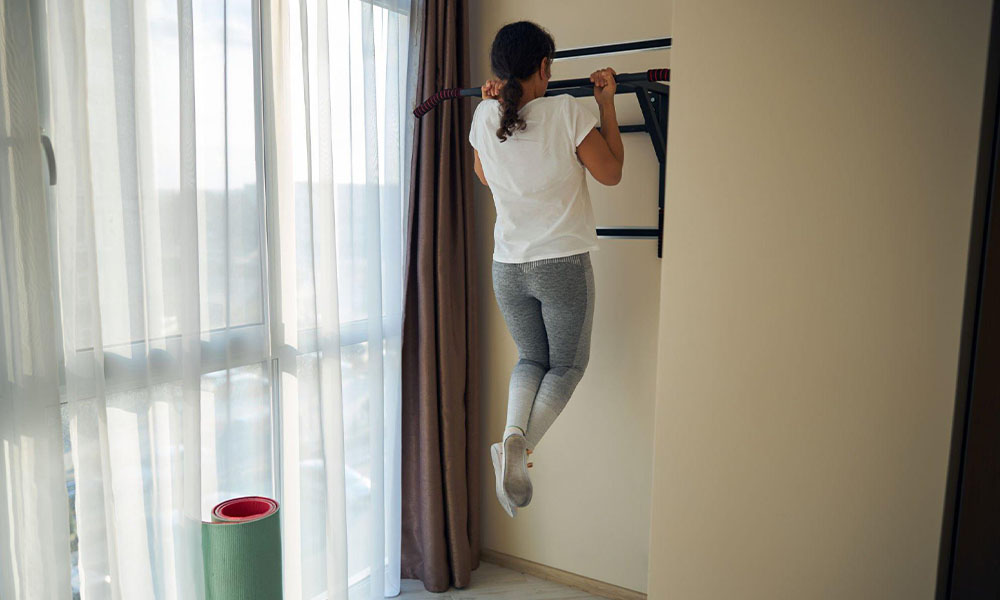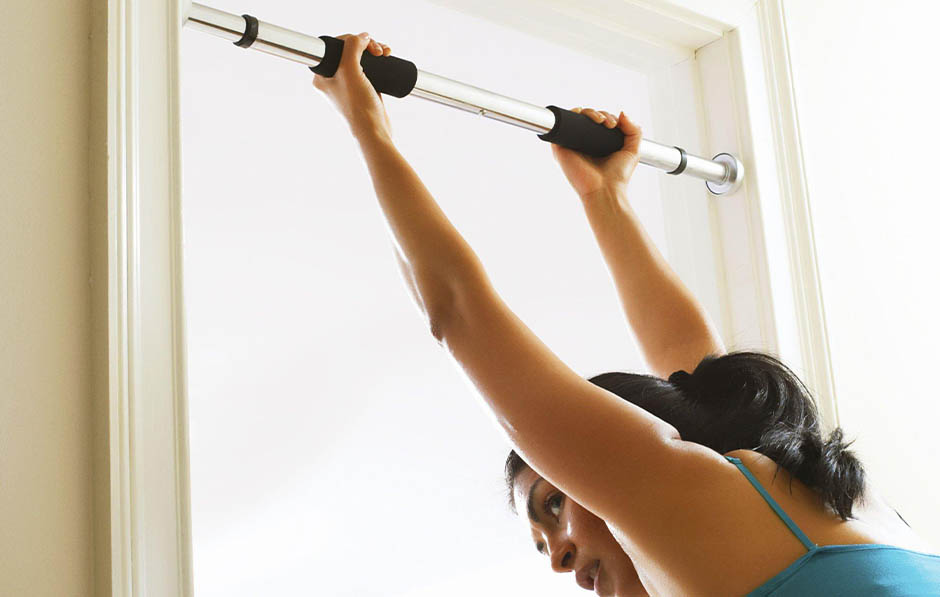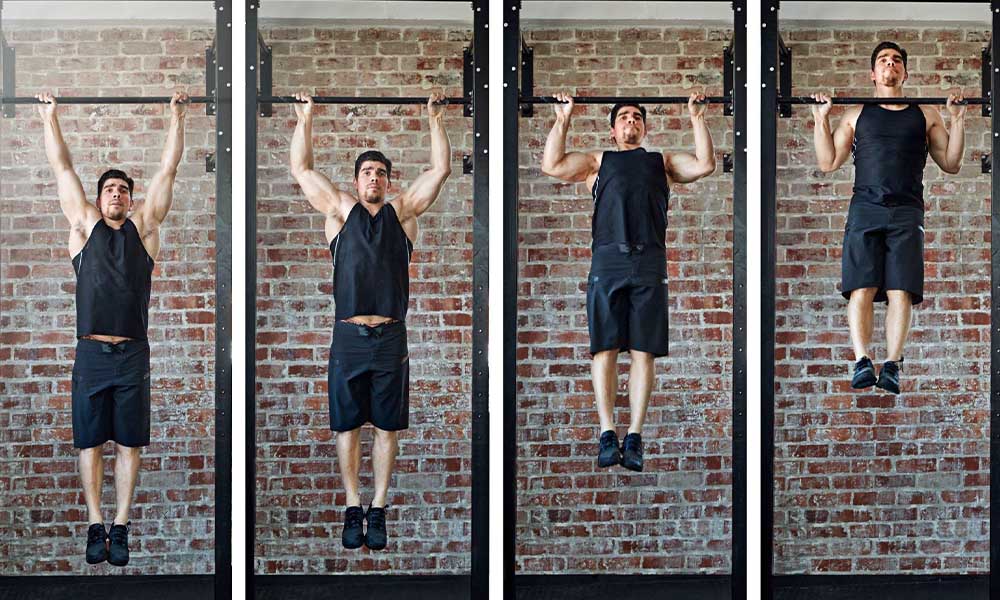Are you looking for a simple yet effective way to enhance your home gym and take your fitness routine to the next level? Look no further than a pull-up bar! This versatile piece of equipment offers a range of benefits that can help you get fit, build strength, and achieve your fitness goals. Whether you’re an experienced athlete or just starting out on your fitness journey, a pull-up bar is a must-have tool for your home gym.
In this article, we’ll explore the numerous benefits of adding a pull-up bar to your workout routine, from improving your posture and core strength to building upper body muscles and boosting your overall health and well-being. So, let’s get started and discover how a pull-up bar can help you become the strongest, fittest version of yourself!
Table of Contents
ToggleBenefits of pull-up bars

Pull-up bars offer a range of benefits that can help you achieve your fitness goals faster and more effectively. One of the primary benefits of pull-up bars is that they help you build upper body strength, particularly in your back, arms, and shoulders. This is because pull-ups require you to lift your entire body weight, which is a challenging exercise that targets many different muscle groups.
In addition to building upper body strength, pull-up bars also help you improve your posture and core strength. When you perform pull-ups, you engage your core muscles, which are essential for good posture and overall stability. By strengthening your core muscles, you can improve your balance and reduce your risk of injury.
Another benefit of pull-up bars is that they are a versatile piece of equipment that can be used for a variety of different exercises. For example, you can use a pull-up bar to perform chin-ups, pull-ups, hanging leg raises, and many other exercises that target different muscle groups. This makes a pull-up bar a great investment for your home gym, as it allows you to perform a wide range of exercises without having to buy multiple pieces of equipment.
Looking to get a full-body workout? Look no further! Visit our page now to discover the Top 10 Exercises for a Full-Body Workout. Whether you’re a beginner or a fitness enthusiast, these exercises are sure to help you achieve your fitness goals.
Different types of pull-up bars

There are several different types of pull-up bars that you can choose from, depending on your preferences and budget. The most common types of pull-up bars are doorway pull-up bars, wall-mounted pull-up bars, and freestanding pull-up bars.
Doorway pull-up bars are the most affordable and convenient option, as they can be easily installed in any doorway without the need for any additional hardware. These bars typically have adjustable pads that fit snugly against the doorframe, providing a secure and stable base for your pull-ups.
Wall-mounted pull-up bars are a more permanent option that requires installation into a solid wall. These bars are typically more durable and stable than doorway pull-up bars, making them a great choice for serious athletes and fitness enthusiasts.
Freestanding pull-up bars are the most versatile option, as they can be moved around and used in different locations. These bars typically have a sturdy base and a tall frame that allows you to perform a wide range of exercises, including pull-ups, dips, and leg raises.
How to install a pull-up bar at home

Installing a pull-up bar at home is a relatively simple process that can be completed in just a few minutes. If you’re using a doorway pull-up bar, simply place the bar in the doorway and adjust the pads until they fit snugly against the doorframe. For wall-mounted and freestanding pull-up bars, follow the manufacturer’s instructions to securely attach the bar to the wall or base.
It’s important to ensure that your pull-up bar is securely attached and can support your weight before you start using it. Check the installation regularly and tighten any bolts or screws as needed to ensure that the bar remains stable and secure over time.
Exercises you can do with a pull-up bar

There are many different exercises that you can do with a pull-up bar, depending on your fitness level and goals. Some of the most popular exercises include pull-ups, chin-ups, hanging leg raises, and dips.
- Pull-ups are one of the most challenging exercises you can do with a pull-up bar, as they require you to lift your entire body weight using only your arms and back muscles. Start by gripping the bar with your palms facing away from you, then lift yourself up by pulling your elbows down towards your sides. Lower yourself back down slowly and repeat for several reps.
- Chin-ups are a similar exercise to pull-ups, but with your palms facing towards you. This exercise targets your biceps and is slightly easier than pull-ups, making it a great option for beginners.
- Hanging leg raises are a great exercise for your core muscles, as they require you to lift your legs up while hanging from the bar. Start by hanging from the bar with your legs straight, then lift your legs up towards your chest. Lower them back down slowly and repeat for several reps.
- Dips are another great exercise that you can do with a pull-up bar, as they target your triceps and chest muscles. To perform dips, grip the bar with your palms facing towards you, then lower yourself down until your arms are at a 90-degree angle. Push yourself back up and repeat for several reps.
Tips for using a pull-up bar safely and effectively
To get the most out of your pull-up bar workouts, it’s important to use the equipment safely and effectively. Here are some tips to help you get started:
- Warm up before each workout to prevent injury and improve your performance.
- Use proper form when performing each exercise to target the right muscles and avoid strain on your joints.
- Start with easier exercises and gradually increase the difficulty as you get stronger.
- Take breaks between sets to prevent fatigue and give your muscles time to recover.
- Incorporate other exercises into your workout routine to target different muscle groups and prevent boredom.
Pull-up bar workouts for beginners

If you’re new to using a pull-up bar, it’s important to start with easier exercises and gradually work your way up to more challenging workouts. Here are some beginner-friendly pull-up bar workouts to help you get started:
- Set 1: 5 pull-ups, 10 push-ups, 15 air squats. Rest for 1 minute and repeat for 3-5 rounds.
- Set 2: 5 chin-ups, 10 dips, 15 hanging leg raises. Rest for 1 minute and repeat for 3-5 rounds.
- Set 3: 5 Australian pull-ups, 10 diamond push-ups, 15 reverse crunches. Rest for 1 minute and repeat for 3-5 rounds.
Advanced pull-up bar workouts
If you’re an experienced athlete or fitness enthusiast, you can try more advanced pull-up bar workouts to challenge your strength and endurance. Here are some ideas to get you started:
- Set 1: 10 muscle-ups, 20 handstand push-ups, 30 toes-to-bar. Rest for 2 minutes and repeat for 3-5 rounds.
- Set 2: 10 one-arm pull-ups, 20 dips, 30 L-sit holds. Rest for 2 minutes and repeat for 3-5 rounds.
- Set 3: 10 bar muscle-ups, 20 push-ups, 30 leg raises. Rest for 2 minutes and repeat for 3-5 rounds.
Pull-up bar accessories to enhance your workout

To enhance your pull-up bar workouts and add variety to your routine, you can also invest in some accessories. Some popular pull-up bar accessories include:
- Resistance bands: These bands can be looped around the pull-up bar to assist with pull-ups and other exercises.
- Weighted vests: These vests add extra weight to your workouts, making them more challenging and helping you build strength.
- Grips and gloves: These accessories can help you get a better grip on the bar and prevent calluses and blisters on your hands.
Frequently asked questions about pull-up bars
How many pull-ups should I do per day?
This depends on your fitness level and goals. If you’re just starting out, aim for 3-5 pull-ups per day and gradually increase the number as you get stronger.
Can I do pull-ups every day?
It’s generally safe to do pull-ups every day, as long as you give your muscles time to recover and don’t overdo it.
How long does it take to get good at pull-ups?
This depends on your starting fitness level and how often you practice. With consistent practice, most people can improve their pull-up performance within a few weeks or months.
What types of pull-up bars are available?
There are several types of pull-up bars available, including doorway pull-up bars, wall-mounted pull-up bars, and free-standing pull-up bars. Each type has its own advantages and disadvantages, so it’s important to choose the one that works best for your needs.
How do I use a pull-up bar?
To use a pull-up bar, grip the bar with your hands shoulder-width apart, palms facing away from you. Hang from the bar with your arms fully extended, then pull yourself up towards the bar until your chin is above the bar. Lower yourself back down to the starting position and repeat.
Are pull-ups suitable for beginners?
Pull-ups can be a challenging exercise, especially for beginners. If you’re new to pull-ups, it’s important to start with assisted pull-ups or other modifications to build up your strength before attempting a full pull-up.
Conclusion
A pull-up bar is a versatile and affordable piece of equipment that can help you get fit, build strength, and achieve your fitness goals. By adding a pull-up bar to your home gym, you can improve your posture, build upper body muscles, and boost your overall health and well-being. Whether you’re a beginner or an experienced athlete, there are many different exercises and workouts that you can do with a pull-up bar to challenge your strength and endurance. So why not invest in a pull-up bar today and start reaping the many benefits for yourself?


